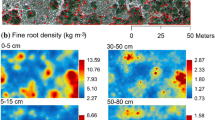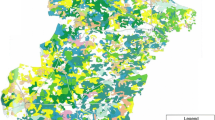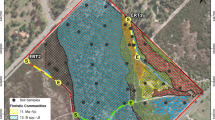Abstract
Fine-scale vegetation patches (<5 m in width) are critically important in many landscapes because they function to obstruct surface flows of water and wind. These obstructions increase the infiltration of runoff and the capture of nutrients in runoff sediments and in wind-blown soil and litter. The importance of redistribution of runoff into runon patches from spaces between patches (fetches) is likely to be greater in drier than in wetter environments. In this paper we examine the hypothesis that the ratio of fetch to patch decreases as rainfall increases, and that this trend will be most evident on intermediate-textured soils because these soils are more prone to runoff. We measured fine-scale patches on 38 sites with sand, loam or clay soils. Sites were located along a 1000-mm rainfall gradient in the savannas of northern Australia. The width and intercept length of patches and the fetch between patches was measuring along line transects of 100–120 m oriented down slope. We found that the ratio of fetch to patch area did not decrease with decreasing rainfall, but increased on both sand and loam soils. This result was because with increasing rainfall mean spacing between patches disproportionally increased while mean patch size and cover declined. The cover of patches was negatively correlated with tree canopy cover, which significantly increased with rainfall. This negative correlation suggests that in higher rainfall savannas the size and spacing of ground-layer patches is controlled by the tree layer, and that as rainfall decreases this control decreases and runoff-runon processes increasingly structure the landscape. For savannas on clay soils these trends were not significant except that on the highest rainfall sites the cover of ground-layer patches was nearly 100% while trees were absent.
Similar content being viewed by others
References
Anderson, V.J. and Hodgkinson, K.C. 1997. Grass-mediated capture of resource flows and the maintenance of banded mulga in a semi-arid woodland. Austr. J. Bot. 45: 331–342.
Andrew, M.H. 1986. Population dynamics of the tropical annual grass Sorghum intrans in relation to local patchiness in its abundance. Austr. J. Ecol. 8: 265–276.
Ash, A.J., Editor. 1996. The Future of Tropical Savannas: An Australian Perspective. CSIRO Publishing, Melbourne.
Bonham, C.D. 1989. Measurements for Terrestrial Vegetation. Wiley & Sons, New York.
Braithwaite, R.W. and Estbergs, J.A. 1985. Fire pattern and woody vegetation trends in the Alligator Rivers region of northern Australia. In Ecology and Management of the World's Tropical Savannas. pp. 359–364. Edited by J.C. Tothill and J.J. Mott, Australian Academy of Science, Canberra.
Clewett, J.F., Clarkson, N.M., Owens, D.T. and Abrecht, D.G. 1994. Australian Rainman: Rainfall Information for Better Management. Queensland Department of Primary Industries, Brisbane.
Cook, G.D. 1994. The fate of nutrients during fires in a tropical savanna. Austr. J. Ecol. 19: 359–365.
Duff, G.A., Myers, B.A., Williams, R.J., Eamus, D., O'Grady, A. and Fordyce, I.R. 1997. Seasonal patterns in soil moisture, vapour pressure deficit, tree canopy cover and pre-dawn water potential in a northern Australian savanna. Austr. J. Bot. 45: 211–224.
Eldridge, D.J. and Greene, R.S.B. 1994. Microbiotic soil crusts: a review of their roles in soil and ecological processes in the rangelands of Australia. Austr. J. Soil Res. 31: 509–518.
Friedel, M.H. 1994. How spatial and temporal scale affect the perception of change in rangelands. Rangeland J. 16: 16–25.
Gillison, A.N. and Brewer, K.R.W. 1985. The use of gradient directed transects or gradsects in natural resource surveys. J. Env. Manag. 20: 103–127.
Ludwig, J.A. and Tongway, D.J. 1995. Spatial organization of landscapes and its function in semi-arid woodlands, Australia. Landscape Ecol. 10: 51–63.
Ludwig, J.A., Tongway, D.J. and Marsden, S.G. 1994. A flow-filter model for simulating the conservation of limited resources in spatially heterogeneous, semi-arid landscapes. Pacific Cons. Biol. 1: 209–213.
McIvor, J.G., Williams, J. and Gardner, C.J. 1995. Pasture management influences runoff and soil movement in the semi-arid tropics. Austr. J. Exp. Agric. 35: 55–65.
Mott, J.J., Bridge, B.J. and Arndt, W. 1979. Soil seals in tropical tall grass pastures of northern Australia. Austr. J. Soil Res. 17: 483–494.
Noy-Meir, I. 1981. Spatial effects in modelling of arid ecosystems. In Arid-land Ecosystems: Structure, Functioning and Management, Vol. 2. pp. 411–432. Edited by D.W. Goodall and R.A Perry. Cambridge University Press, Sydney.
Scanlan, J.C. and Burrows, W.H. 1990. Woody overstorey impact on herbaceous understorey in Eucalyptus spp. communities in central Queensland. Austr. J. Ecol. 15: 191–197.
Scanlan, J.C., Pressland, A.J. and Myles, D.J. 1996. Grazing modifies woody and herbaceous components of north Queensland woodlands. Rangeland J. 18: 47–57.
Scholes, R.J. and Archer, S.R. 1997. Tree-grass interactions in savannas. Ann. Rev. Ecol. Syst. 28: 517–544.
Schulze, E.-D., Williams, R.J., Farquhar, G.D., Schulze, W., Langridge, J., Miller, J.M. and Walker, B.H. 1998. Carbon and nitrogen isotope discrimination and nitrogen nutrition of trees along a rainfall gradient in northern Australia. Austr. J. Plant Physiol. 25: 413–425.
Tongway, D.J. and Hindley, N. 1995. Manual for Soil Condition Assessment of Tropical Grasslands. CSIRO Wildlife and Ecology, Canberra.
Tongway, D.J. and Ludwig, J.A. 1994. Small-scale resource heterogeneity in semi-arid landscapes. Pacific Cons. Biol. 1: 201–208.
Tongway, D.J. and Ludwig, J.A. 1997a. The conservation of water and nutrients within landscapes, Chapter 2. In Landscape Ecology, Function and Management: Principles from Australia's Rangelands. pp. 17–26. Edited by J. Ludwig, D. Tongway, D. Freudenberger, J. Noble and K. Hodgkinson, CSIRO Publishing, Melbourne.
Tongway, D.J. and Ludwig, J.A. 1997b. The nature of landscape dysfunction in rangelands, Chapter 5. In Landscape Ecology, Function and Management: Principles from Australia's Rangelands. pp.53–65. Edited by J. Ludwig, D. Tongway, D. Freudenberger, J. Noble and K. Hodgkinson, CSIRO Publishing, Melbourne.
Turner, M.G. 1989. Landscape ecology: the effect of pattern on process. Ann. Rev. Ecol. Syst. 20: 171–197.
Walker, B.H. 1993. Rangeland ecology: understanding and managing change. Ambio 22: 80–87.
Walker, B.H. 1996. Having or eating the rangeland cake: a developed world perspective on future options. In Rangelands in a Sustainable Biosphere Vol. II. pp. 22–28. Edited by N. West. Society for Range Management, Denver.
Walker, B.H., Langridge, J.L. and McFarlane, F. 1997. Resilience of an Australian savanna grassland to selective and non-selective perturbations. Austr. J. Ecol. 22: 125–135.
Walker, B.H. and Langridge, J.L. 1997. Predicting savanna vegetation structure on the basis of plant available moisture (PAM) and plant available nutrients (PAN): a case study from Australia. J. Biog. 24: 813–825.
Wiens, J.A., Stenseth, N.C., Van Horne, B. and Ims, R.A. 1993. Ecological mechanisms and landscape ecology. Oikos 66: 369 380.
Williams, M.A.J. 1969. Prediction of rainsplash erosion in the seasonally wet tropics. Nature 22: 763–765.
Williams, R.J., Cook, G.D., Gill, A.M. and Moore, P.H.R. 1999. Fire regime, fire intensity and tree survival in a tropical savanna in northern Australia. Austr. J. Ecol. 24: 50–59.
Williams, R.J., Duff, G.A., Bowman, D.M.J.S. and Cook, G.D. 1996. Variation in the composition and structure of tropical savannas as a function of rainfall and soil texture along a large-scale climatic gradient in the Northern Territory, Australia. J. Biog. 23: 747–756.
Wilson, B.A., Brocklehurst, P.S., Clark, M.J. and Dickinson, K.J.M. 1990. Vegetation Survey of the Northern Territory, Australia. Technical Report Number 49, Conservation Commission of the Northern Territory, Palmerston.
Author information
Authors and Affiliations
Rights and permissions
About this article
Cite this article
Ludwig, J.A., Tongway, D.J., Eager, R.W. et al. Fine-scale vegetation patches decline in size and cover with increasing rainfall in Australian savannas. Landscape Ecology 14, 557–566 (1999). https://doi.org/10.1023/A:1008112122193
Issue Date:
DOI: https://doi.org/10.1023/A:1008112122193




